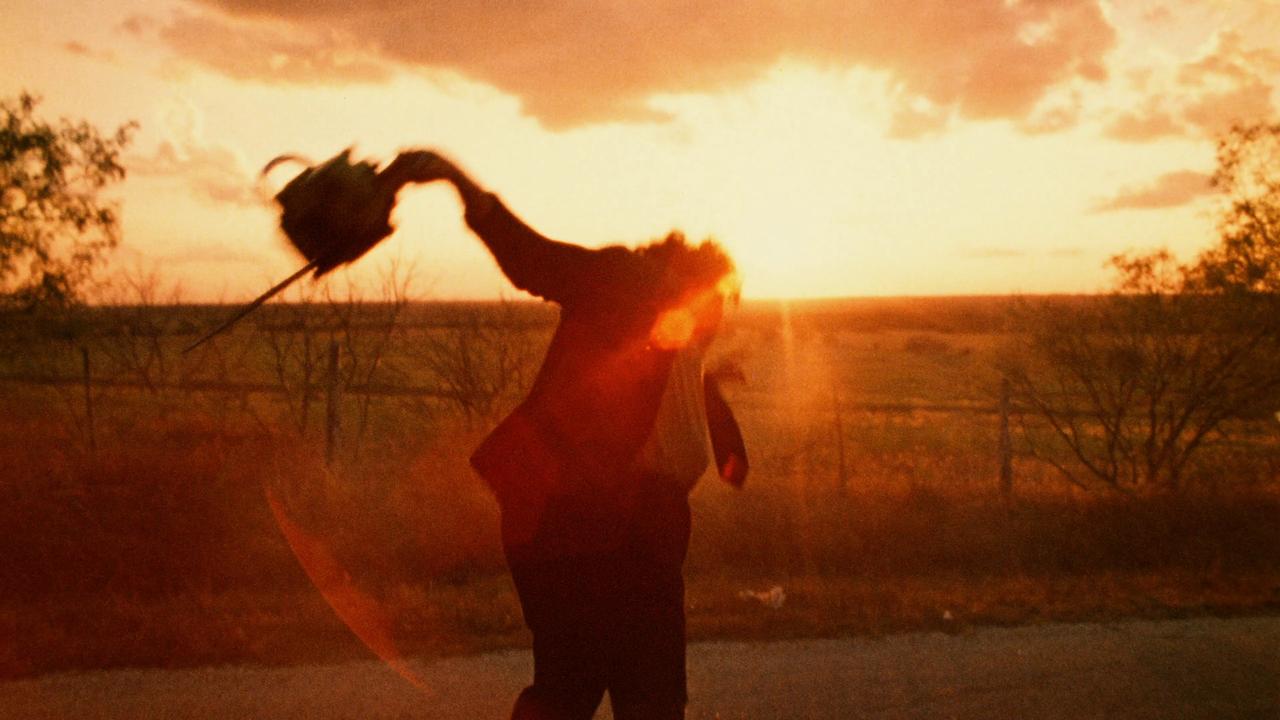Table of Contents Show
This article contains spoilers for Texas Chainsaw Massacre (2022); please be aware the following also contains graphic mentions of blood, gore, and disturbing imagery.
The sweltering haze of violence and terror in Tobe Hooper’s The Texas Chainsaw Massacre (1974) was executed so effectively that it went on to be banned in several countries. Approaching 50 years later, Texas Chainsaw is still considered one of the most horrifying films of all time, despite its lack of explicit gore. The same cannot hold true for David Blue Garcia’s confusingly titled, Texas Chainsaw Massacre (2022), which is now streaming on Netflix. This film foregoes all other sequels to TCM 1974, directly following the events of the original, and creating yet another universe in the Texas Chainsaw series.
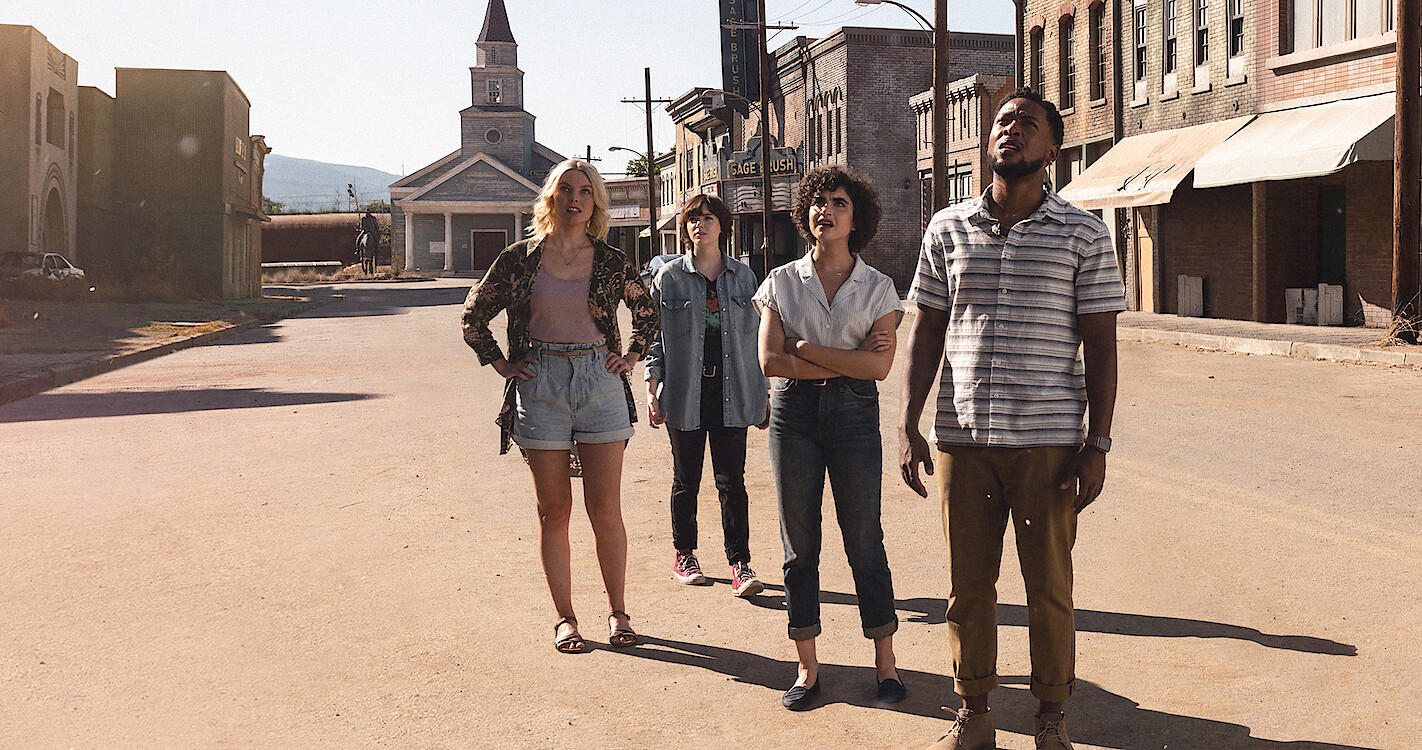
Following a deeply unlikable quartet of impudent characters — Melody (Sarah Yarkin), Lila (Elise Fisher), Dante (Jacob Latimore), and Ruth (Nell Hudson) — TCM 2022 begins with the protagonists arriving in the ghost town of Harlow, Texas to “clean it up” for potential investors. In other words, a group of influencers drives into town with big hopes of gentrifying the place. It is a poor set-up and equally poor execution in an attempt to create modern relevance. The film goes on to unsuccessfully comment on a variety of contemporary social issues such as: gentrification, racism, school shootings, nature vs. nurture, and influencer culture; all within 81 minutes of screen time. Texas Chainsaw Massacre (2022) lacks the somber innovation that made The Texas Chainsaw Massacre (1974) so naturally terrifying.
Where Did Texas Chainsaw Massacre (2022) Go Wrong?
Like many horror series, the original Texas Chainsaw film has a certain je ne sais quai that the sequels fail to achieve. Book of Shadows: Blair Witch 2 (2000; Joe Berlinger), The Amityville Curse (1990; Tom Berry), Halloween: Resurrection (2022; Rick Rosenthal), and Jaws: The Revenge (1987; Joseph Sargent) are just a few unfortunate examples of lackluster sequels. On some level, this is an expected side-effect of sequels. The tonal shift between TCM 1974 and TCM 2022, however, is immense;
“Tobe Hooper’s Texas Chainsaw Massacre derived a lot of its terror from sheer randomness—the notion that there are gleeful psychos lurking on the outskirts of civilization, indiscriminately killing anyone who blunders into their world, every human reduced to squealing ‘meat’ on their butcher’s table. But in the new Texas Chainsaw Massacre, there’s no such thing as a senseless killing. Everyone is connected; everything is laden with meaning.”
(( O’Neal, Sean, “The New ‘Texas Chainsaw Massacre’: They Came, They Sawed, They Didn’t Cut It.” Texas Monthly. 18 Feb 2022. ))
This excessive planning is why fans of the series find themselves disappointed at best (and angered at worst) in their feelings towards the film; it no longer feels like a Texas Chainsaw movie. Albeit, there is one aspect of the film that stays on par to the original – the cinematography. Director Garcia, and cinematographer Ricardo Diaz, tastefully captured the grueling Texas heat and musky atmosphere that first accompanied Hooper’s film.
In an interview with Variety, Diaz spoke to his admiration for Daniel Pearl, TCM 1974’s cinematographer: “The original is a beautiful nightmare that mixes documentary and cinema styles with a haunting effect. The use of color reversal 16mm film gives the film a contrast, saturation, and grain that heightens its grindhouse aesthetic” (( Tangcay, Jazz. “How ‘Texas Chainsaw Massacre’ Captured Leatherface’s Dance in One Take.” Variety. 25 Feb, 2022. )). Knowing Texas Chainsaw stems from a rich visual history, Diaz channeled this aesthetic, paying respects to the original grainy disposition of The Texas Chainsaw Massacre and creating some of the most stunning shots in the series.
Leatherface or Michael Myers?
In TCM 1974, “Leatherface is a deformed man with an intellectual disability” (( Tahernia, Cameron. “Texas Chainsaw Massacre: What Makes The Original Film So Iconic.” Movieweb. 7 Mar 2022. )). The viewer watches as he is ridiculed and abused by his family throughout the film; doing their dirty work and at their mercy. When Leatherface kills, it is for basic survival, and “after killing the first two teens in the film, [he] seems frightened, grasping at his mask. He doesn’t know who these people are or why they keep coming onto his property” (( Tahernia, Cameron. “Texas Chainsaw Massacre: What Makes The Original Film So Iconic.” Movieweb. 7 Mar 2022. )). This predicament is what makes Leatherface such a compelling character — he is a figure just as scared and just as stuck as the unlucky protagonists find themselves.
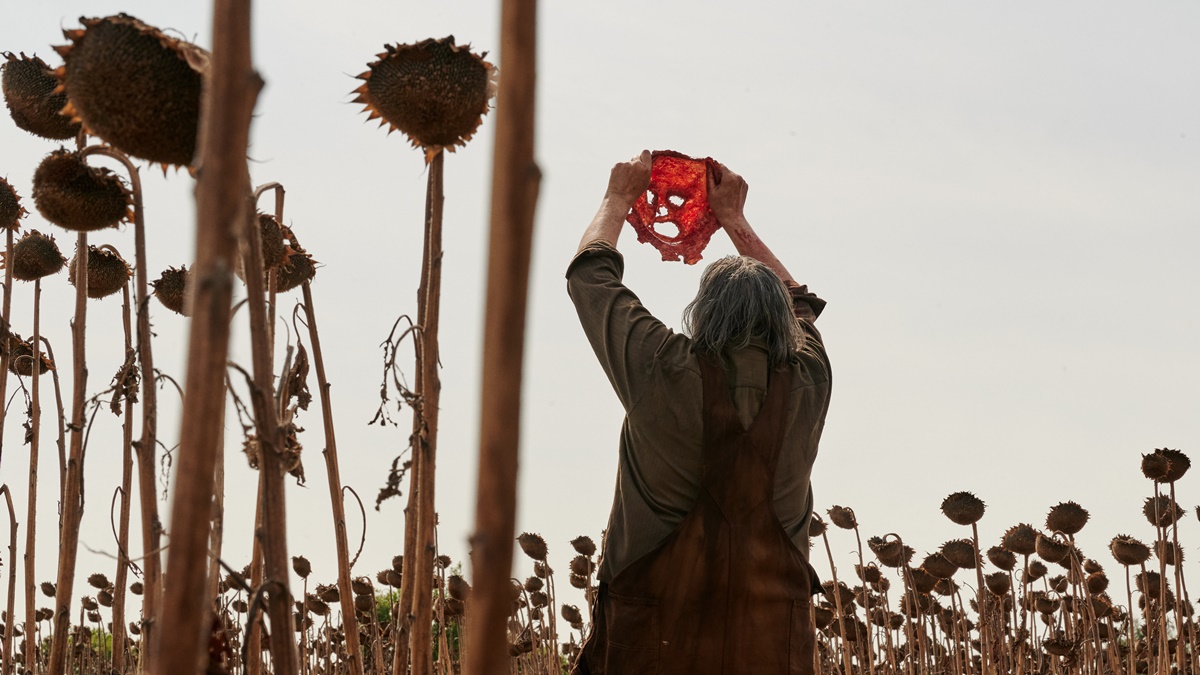
The new Texas Chainsaw shows a change in character. Only a hint of the original Leatherface remains, aside from his mask made of human flesh and trademark weapon. In TCM 1974, Leatherface killed out of obligation and fear. Now, he is shown killing with brute violence and bloodlust for revenge. He becomes akin to a classic slasher killer like Michael Myers in Halloween (1978; John Carpenter). Here, Leatherface is too intelligent, creating elaborate traps and throwing chainsaws with calculated ambition.
It’s All In the Family
TCM 2022 uniquely situates the viewer in an empathetic position to Leatherface. It is easy to understand his anger, and moments of the film feel as though the audience should root for Leatherface, an effortless task with protagonists annoying and disrespectful as the chosen quartet (Lila aside). Their exasperating behavior is displayed when the characters discover a weather-torn confederate flag hanging from the window of a decrepit home along Harlow’s main (and only) street.
Melody and Dante break into the home, trying to tug the flag down. Mistakenly thought to be abandoned, they run into a startled elderly woman who they then proceed to kick out of her own home, insisting they now own the title to her house. The upset leads to the old lady dying from heart failure in the ambulance to the hospital. Naturally, she is accompanied by her adoptive son and caretaker, none other than Leatherface himself.
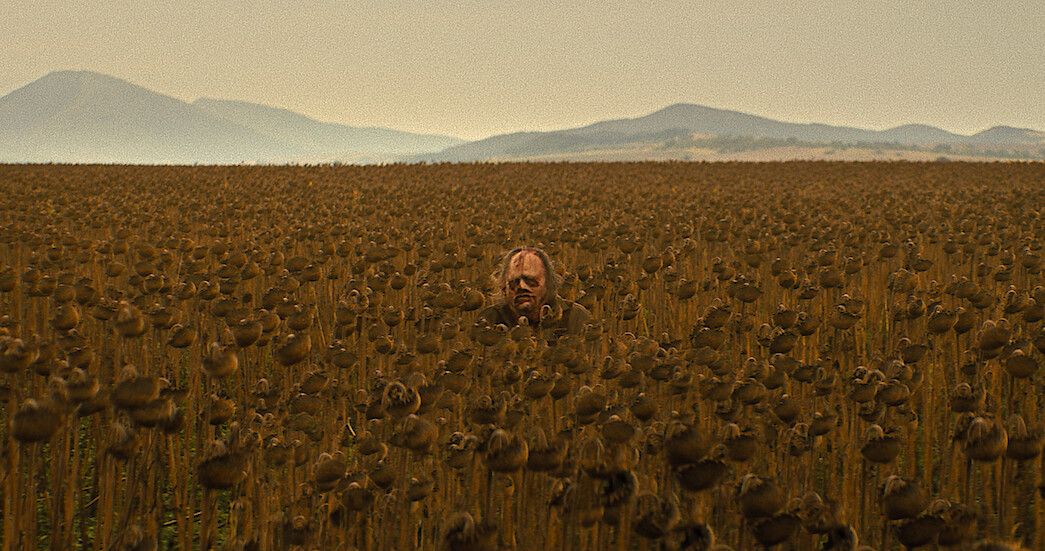
Texas Chainsaw Massacre (2022) creates endless questions for fans of the original film. After the events of Texas Chainsaw (1974), Leatherface, apparently, left home and wandered into an orphanage (despite being a grown adult) and became a docile, adoptive son to this old lady. Was he forced to leave home after failing to capture Sally? Did he choose to leave after his family eventually died? It’s not clear. What is known is as follows: Leatherface watches his mother-figure die, and flips into a furious creature, proceeding to kill as many people as he can to exact his revenge. Gone is the cannibal family, slighted by their government and forced to survive through their animal instincts.
Here is where much of the horror that guided the original Texas Chainsaw dissipates. While inarguably transfixing from the start, Leatherface was never the sole antagonist of the film — the Sawyer family, as a whole, was. And, The Texas Chainsaw Massacre‘s sociopolitical commentary on the working-class family is essential to fully understand the terror of the film. The 1970s were a time of social turmoil in America with mass resentment towards the Vietnam War, and the economic crisis that came with it. TCM 1974 is a film about the neglect of the working class and why much of the terror of the film came from the Sawyer family; “A nightmare vision of rural America lashing out at the industrial society that rendered it obsolete” (( O’Neal, Sean, “The New ‘Texas Chainsaw Massacre’: They Came, They Sawed, They Didn’t Cut It.” Texas Monthly. 18 Feb 2022. )).
The Calm Before The Gore
Both TCM 1974 and TCM 2022 are rated “R” for “restricted” by the Motion Picture Association of America (MPAA) but have very different executions of gore and explicit violence. The original Texas Chainsaw may not be the goriest horror film but is bone-chilling nonetheless. In contrast, the newest sequel lacks the terrifying nature but is a bloody mess (in more ways than one).
TMC 1974 + Gore
The tricky part about Texas Chainsaw Massacre sequels is that they will never be able to capture the raw magic of filmmaking that happened in the summer of 1973, for better or for worse. The shooting for TCM 1974 was in stifling southern heat, and descriptions of filming conditions sound nothing short of abysmal. The farmhouse where a majority of the filming took place was decorated with decay and animal bones that mixed unpleasantly with the dreadful humidity. Those on the scene recount taking breaks to vomit and pausing for a breath of fresh air as the food on set began to rot from the heat of Texas summer and the lighting equipment. As a result of these abysmal conditions, in tandem with Hopper’s low budget and casting of unknown actors, The Texas Chainsaw Massacre has an eerie documentary feel to it, adding to the film’s horror.
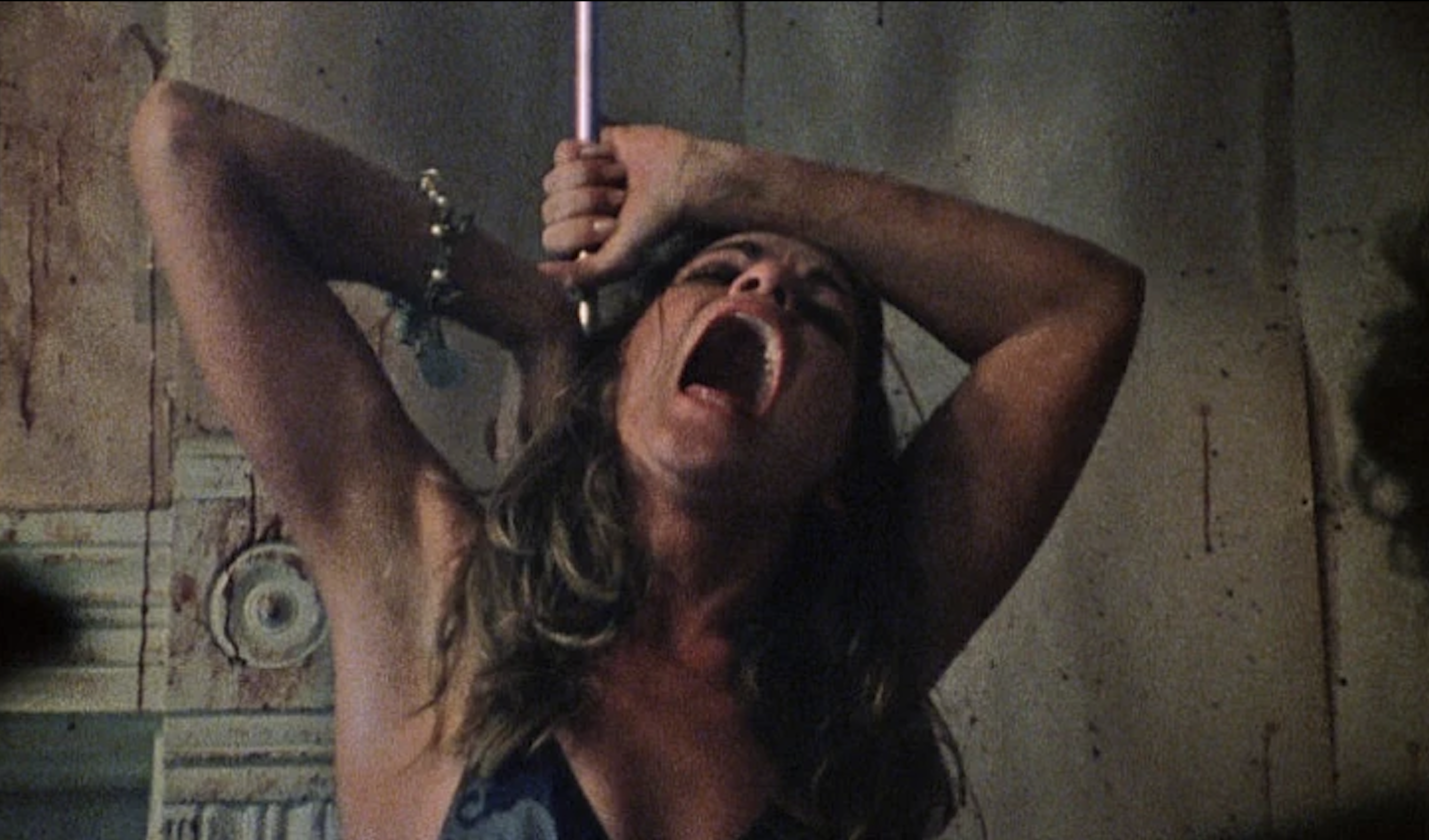
TCM 1974 did not rely on the excessive use of gore to scare viewers; the production did not need to depend on such graphic nature. The film’s slow and deliberate pacing, building into outright terror, is as fast and starling as a revving chainsaw. Ironically, the film getting banned was the opposite of Hopper’s intent. When he set out to make Texas Chainsaw, it was with the hopes of achieving a PG rating from the MPAA. Language and explicit gore were intentionally limited with this in mind. However, Hopper did not count on how efficacious his storytelling would prove to be.
When violence occurs in the film, it is often with the suggestion of it, rather than an actual depiction. That, although, is still enough to inspire racing hearts and sweaty palms. Using sound, editing, and framing, he was able to suggest bloodletting and gruesome gore without physically showing it. One particular scene that showcases this technique is the meat hook. As poor Pam wanders into the old farmhouse to see what is taking her boyfriend (Kirk) so long, she is captured by Leatherface. Fighting tool and nail, she is dragged into the farmhouse.
The shot changes from the pair struggling in the hallway to show an ominously swinging meat hook in the foreground. Pam, squirreling in Leatherface’s grip, desperately tries to escape but is no match against Leatherface. The viewer does not see the hook pierce her skin, but watches as Pam’s face turns into a mixture of intense shock and horror as whimpers of disbelief emanate from the poor girl. All the worse, Pam is clad in only red shorts and a halter top, leaving much of her back exposed. Just thinking about the situation is shiver-inducing.
TCM 2022 + Gore
However, Texas Chainsaw Massacre (2022) is an explicit gorefest that remains stasis in its action. It is equivalent to a Halloween film, trying to follow the franchise’s success with Michael Myers. Still, this is a Texas Chainsaw sequel, not a Halloween sequel. TCM 2022 is fatally reliant on mindless gore and serial killing. No payoff comes from a slow start, as the first killings begin with explicit gore and end with explicit gore. Characters are cut, slashed, attacked, hacked, chased, and taunted by a chainsaw-wielding maniac.
Leatherface could be replaced with any random serial killer here, just as this film could be any random slasher film detached from the name “Texas Chainsaw.” Truthfully, films like TCM 2022 no longer cut it for viewers. If a production is aiming to create a successful and contemporary slasher, the film needs to come from an established slasher series like Scream (1996; Wes Craven), or have a unique and innovativeness twist to it like Ready or Not (2019; Matt Bettinelli-Olpin and Tyler Gillett).
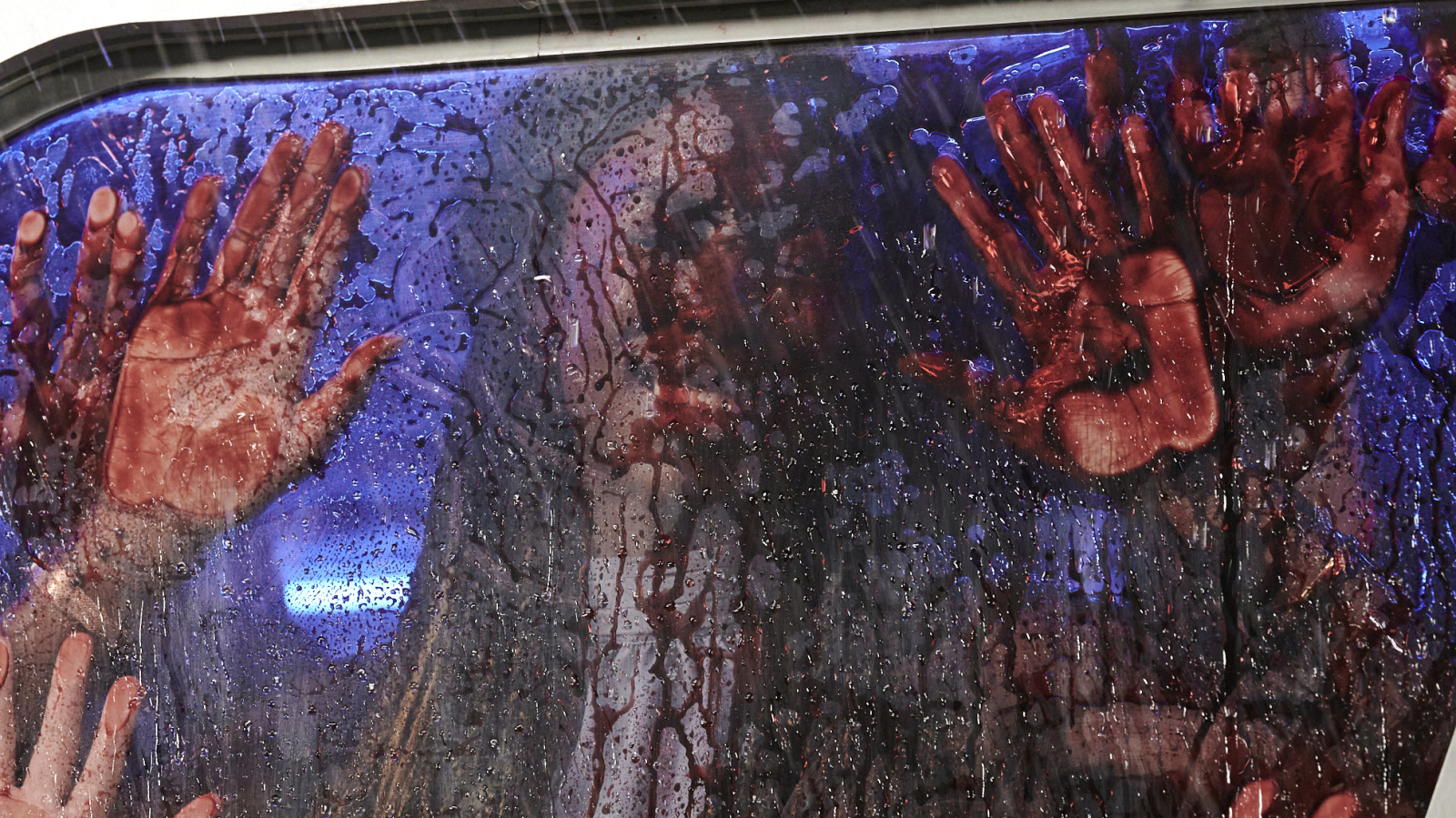
There is one scene that, briefly, works well for this film — the bus massacre. It is a moment of true horror film glory. In the scene, “Leatherface goes ripping through a crowded, neon-lit party bus while everyone just stands there, live-streaming it on their phones and threatening to ‘cancel’ him. It’s ludicrous and, for a brief moment, fun” (( O’Neal, Sean, “The New ‘Texas Chainsaw Massacre’: They Came, They Sawed, They Didn’t Cut It.” Texas Monthly. 18 Feb 2022. )). Yet, the moment quickly dies when one remembers there was no reason for why the bus driver stopped, or why the woman who ran on the bus telling the driver to speed away forgot to mention the raging killer outside. To top it off, this is another moment where viewers are not technically supposed to root for Leatherface but…Leatherface vs. The Gentrifying Influencers…who wants to be on the influencers side here?
This is one of the reasons TCM 2022 fails. The original Texas Chainsaw had no room to root for Leatherface or the cannibal Sawyer family. The viewer identifies with Sally and wants, begs for her to escape. There is no room to justify or rally for their inhumane torture. TCM 2022 presents our main characters, and their guests, so unlikeable that it becomes terribly easy to cheer for their deaths in a moment of actual interest within the otherwise dull film.
Trying Too Much
Mr. Leatherface, how many licks does it take to get to the center of Texas Chainsaw‘s sociopolitical relevance? A one, a two, a three…a four, a five, a six? As mentioned earlier, TCM 2022 tries to tackle a vast array of topics, all with little effect. The film does not seem to know what it stands for and, “it feels like a crass bid for topicality. And it continually brings the film to a screeching halt, asking the viewer to stop and reflect on our tragic, real-world violence before it gets back to the decapitations” (( O’Neal, Sean, “The New ‘Texas Chainsaw Massacre’: They Came, They Sawed, They Didn’t Cut It.” Texas Monthly. 18 Feb 2022. )).
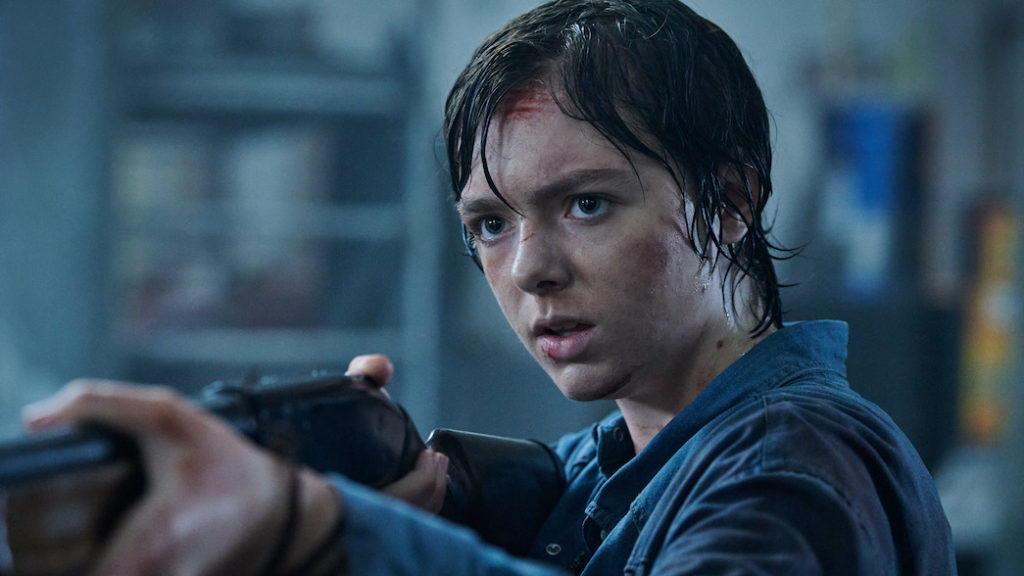
Lilia is a survivor of a school shooting, which the viewer first learns of when discovering why she is on this trip with her sister, Melody, and her influencer friends. The film attempts to build on this non-existent bond between sisters, but is ineffective. These two characters could just as easily be friends or strangers, and the story would have no little to no effect. It would be too generous to say that TCM 2022 clumsily strives to unpack Lila’s trauma or make any real comment on gun control.
Instead, the film chooses to mostly ignore it until Lila is forced to pick up a machine rifle to defend herself. Devoid of nuance, it spends no energy towards this familial bond or creating any real character growth for Lila. Alternatively, the viewer watches a traumatized teenager learn to face her fear of guns…maybe? The film’s stance on guns is blurry at best. Is it advocating for the Stand Your Ground law? Is it trying to suggest Lila is now pro-gun? It is hard to say as the viewer gets nothing in return.
Unfortunately, gun control is just one of many topics this film aims to comment on. Racism is bad, and every Texan is inherently a racist, gun-wielding hick, right? This makes gentrifying the run-down town of Harlow, okay. But gentrification is horrible, so Leatherface is actually right? If none of this is making sense, it perfectly captures the confusion felt watching the film. Leaving more questions than it answers, Texas Chainsaw Massacre is a desperate attempt at relevancy that falls short again, and again, and again.
Crunch.
Less Is More
Dropping the article “The” from The Texas Chainsaw Massacre was an amusing move on David Blue Garcia’s part, mostly because this validates the viewers’ doubts — this is simply a Texas Chainsaw film, not the Texas Chainsaw film. It fails at being an effective horror sequel, especially to a work as iconic as the revolutionary mayhem of The Texas Chainsaw Massacre. Trying to integrate too many topics, in too little time, with too little nuance, TCM 2022 proves that less is, often, more.
